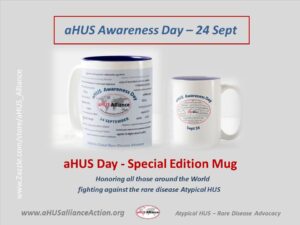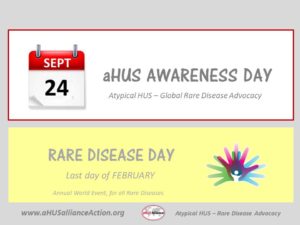
aHUS Awareness Day & Rare Disease Day
Sharing information is a key part of advocacy – Check out our aHUS Press Kit, Fact Sheets
and other assets within our Index of Key Resources
Info & Advocacy: an IMAGE GALLERY
Information and Resources
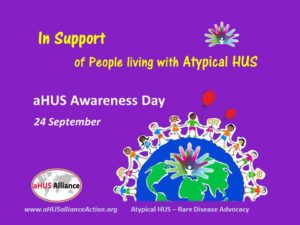
aHUS AWARENESS DAY
24 September – an annual day to highlight the issues,
challenges, and remarkable individuals within the aHUS community
The aHUS Alliance created the 1st aHUS Awareness Day in 2015 to raise visibility about the rare disease atypical hemolytic uremic syndrome (atypical HUS). Since then, the aHUS Alliance global action team has led this annual 24 September campaign creating fact sheets, graphics, and resources to serve the needs of patients and caregivers as well as clinicians and the general public.
Our website offers original content created by an international volunteer team of aHUS patient advocates and family caregivers. Our articles that express global patient voices and collaborative efforts with aHUS research teams and advocacy groups.
Brief History & FAQs
Why 24 September?
September 24, 2015 was selected as the inaugural date for the first aHUS Awareness Day because during this same week 60 years ago the term Haemolytic Uraemic Syndrome first appeared in medical literature. HUS was given its name by Conrad von Gasser, when he and his research team described in an article for a Swiss clinical publication the illness they had been studying which caused blood clotting, anemia and kidney failure. Read more HERE and HERE.
We invite you to explore our aHUS Press Kit (General Information, Assets & Resources)
What is atypical HUS?
Video & Info: aHUS National Service U.K.
Genetic Atypical Hemolytic-Uremic Syndrome – GeneReviews®
When was aHUS first noted in medicine?
Who was Conrad von Gasser? for a Deeper Dive: Life & Achievements of Conrad von Gasser
What are the different names & spellings for aHUS?
What is atypical HUS and how is it similar/different to the more common diagnosis of HUS?
aHUS Awareness Day – Campaigns & Images
aHUS Image Gallery – Informational & Advocacy Images
aHUS Awareness Day on Twitter @aHUS24Sept
Our Main Hashtag: #aHUS24Sept (also: #aHUSday #aHUSaware #SHUa24Sept #aHUSawareness #aHUSawarenessDay)
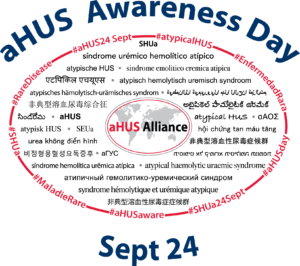
24 September Campaigns
24 September Campaigns: aHUS Awareness Day Articles & Projects
2024: aHUS Awareness Day Campaign
Mental Health – Theme for 24 Sept 2024
Article about the 2024 aHUS Day Campaign
View the Project: https://bit.ly/2024aHUS24Sept
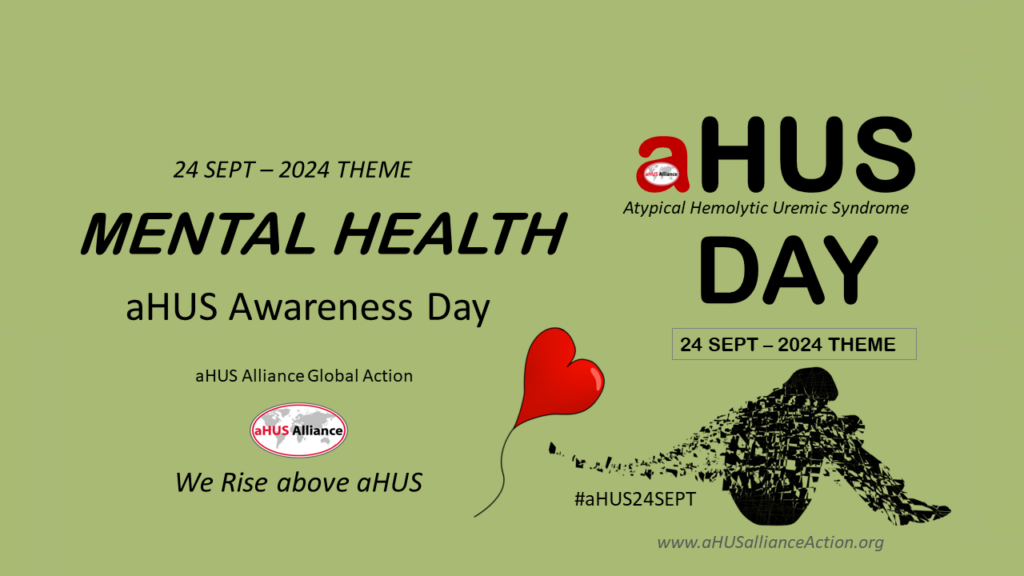
2023: aHUS Day Campaign
Capabilities & Possibilities – Theme for 24 Sept 2023
2023 – SEPT – 2024: Atypical HUS FACT SHEET
Article about the 2023 aHUS Day Campaign
QR Code Sheet – SEPT 2023 Edition Quick Assets to Key Info & Assets
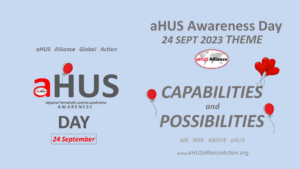
2022: aHUS Day Campaign
Awareness through Togetherness – Theme for 24 Sept 2022
Article about the 2022 aHUS Day Campaign
2022 – SEPT – 2023: Atypical HUS FACT SHEET
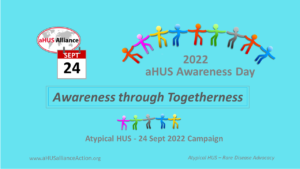
2021 Theme: United in Advocacy – our 2021 Call to Action
Article about the theme & 2021 aHUS Day Campaign
2021 Sept 2022: FAQ for aHUS Awareness Day
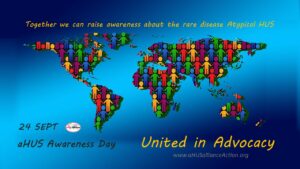
Previous 24 Sept Campaigns
2020:
Article about the theme & 2020 aHUS Day Campaign
About the global Video Project
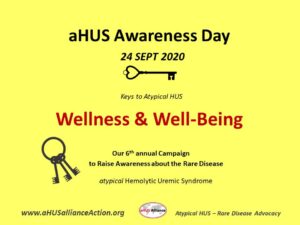
Past aHUS Day Campaigns
2015: 1st Inaugural aHUS Day Campaign
Press Release, 1st world aHUS Awareness Day
View the Project
2016:
Press Release, Campaign: Rising above aHUS
View the Project
2017:
General Info
Article about the Project
View the Project
More: 2017 Campaign
2018:
Article about this Campaign
View the Project
More: 2018 Campaign
2019:
Article about this Campaign
View the Project
aHUS Awareness Day Videos – Created by Patients, Families, and Supporters
Featuring videos about aHUS Day, a special playlist of the aHUS Alliance YouTube channel which focuses on aHUS patient experiences and viewpoints: Atypical HUS Patient Voices
Looking for aHUS Awareness Day items?
From the group that created aHUS Day in 2015, and in response to requests from supporters,
we do offer 24 September items on Zazzle.
Click the image to see the Official aHUS Day storefront
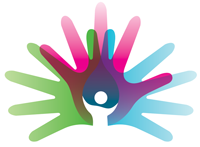
Rare Disease Day – Annual Campaign (FEB 28 or 29th): Global Awareness of Rare Diseases
Rare Disease Day was founded in 2008 by EURORDIS to raise awareness for the people affected by rare medical conditions and for the issues and challenges faced by patients and their families. Policy makers and healthcare systems put their focus on diseases and disorders that affect large patient populations, so rare disease advocacy groups like the aHUS Alliance often rely on families to share their experiences. Through the expertise and volunteer efforts of clinicians and research teams, national patient groups have ability to provide insight into drug access, diagnosis, policy, and other key aspects within their country.
Atypical HUS is one of an estimated 7000+ rare diseases, individually uncommon but collectively affecting perhaps an estimated 1 in 12 people. Rare diseases are defined differently around the world, so Rare Disease Day facts vary. While exact numbers of people diagnosed with aHUS are unknown, it is estimated at 2 people per million and thus sometimes noted as an ultra-rare disease.
As an umbrella group of aHUS advocates and patient organizations in over 30 nations, the aHUS Alliance annually participates in world Rare Disease Day with articles, graphics, and projects with a specific focus on atypical HUS.
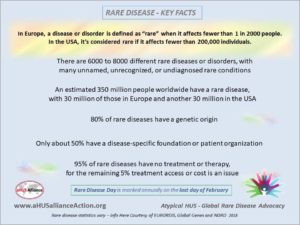
What is Rare Disease Day? (EURORDIS)
As an umbrella group of aHUS advocates and patient organizations in over 30 nations, the aHUS Alliance participates in world Rare Disease Day with articles, graphics, and projects with a specific focus on atypical HUS.
Rare Disease Day – IMAGES & Graphics
(created by the aHUS Alliance Global Action team)
aHUS Alliance – Rare Disease Day CAMPAIGNS
2025:
aHUS Alliance RD Day Project:
Article & Details Watch It
2024:
aHUS Alliance RD Day Project:
Article & Details Watch It
2023:
aHUS Alliance RD Day Project:
Article & Details Watch It
2022:
aHUS Alliance RD Day Project:
Article & Details Watch It
2021:
aHUS Alliance RD Day Project:
Article & Details Watch It
2020:
aHUS Alliance RD Day Project:
Article & Details Watch It
2019:
aHUS Alliance RD Day Project:
Article & Details Watch It
2018:
aHUS Alliance RD Day Project:
Article & Details Watch It
Rare Disease Day 2018: Cohort 1
Rare Disease Day 2018: Cohort 2
2017:
aHUS Alliance RD Day Project:
Article & Details Watch It
Rare Disease Day 2017: Topic Summary
RD Day- aHUS Video Playlist – Created by Patients, Families, and Supporters
RD Day- aHUS Video Playlist – Created by aHUS Patient Groups


